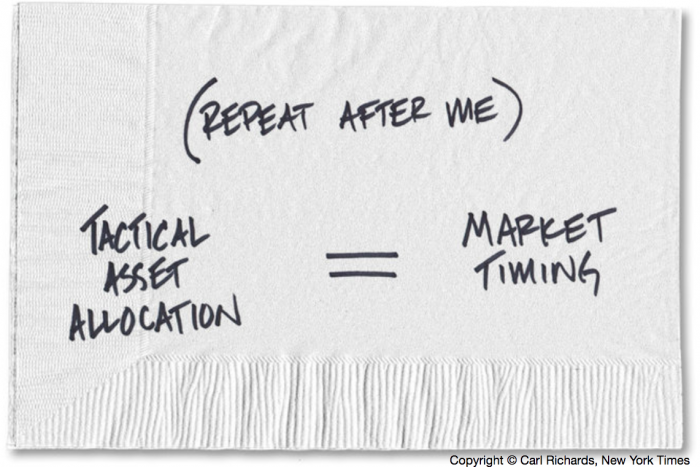by James Picerno, Capital Spectator
Selection bias is everywhere in financial journalism, and for obvious reasons (obvious if you’re in the publishing business). The average reader isn’t interested in a rigorous study of investment track records… yawn. No, the average reader wants sexy stories and profiles of a man (or woman) who beat the odds and delivered stellar returns. Or so it seems, based on a casual review of the usual suspects. I stumbled across another one recently, and it pushes all the obvious buttons. The basic message: the road to uncommonly high returns can be found with an extreme strategy. In this case, the short cut to the promised land runs through a “concentrated” value portfolio that keeps the number of holdings to a minimum and focuses on a select list of securities with the highest expected return. What else do you need to know? Goodbye indexing, so long multi-asset class diversification. They’re done. Now that you have the superior formula, sit back and drink in the success.
The evidence presented is a pension fund that “pretty much breaks all the conventional rules of fund management,” and boasts “unheard of” performance numbers. For example, the fund’s 10-year return through last Sep. 30 was a hefty 9.7%. Now let’s note right up front that this is an impressive gain. As I wrote last fall, the range of trailing 10-year performance data for more than 1,000 multi-asset class mutual funds was in a band of 2.0% up to 12.7% (through Oct. 31, 2013). A 9.7% annualized gain around that time is certainly in the upper ranks of the competition. The comparison looks even better within the pension fund universe, according to the article.
I’m not questioning the fund’s numbers (although I can’t verify them at this point either). My problem here is the device of searching out the extreme performer and elevating the strategy to god-like status. Ok, for all I know the manager may be a genius. Based on the numbers in the story, he certainly deserves praise. But while a man-bites-dog-story is fun to read—and quite common—there’s no discussion here of how we should think about extraordinarily strong returns in a broad portfolio-design context. Well, of course not–we don’t want to put the readers to sleep.
But let’s chance it, anyway. If you look at a universe of 1,000 funds, it’s highly likely that you’ll see numbers in the extreme, for losses and gains. That’s true if we generate artificial data for analyzing a random sample; it’s also true for real-world returns, as the link to my mutual fund analysis above reminds.
But none of this seems to matter when you read a story about the guy who beat the odds and climbed his way to the top. Of course, you’ll never read about his counterpart at the bottom—the manager who somehow ran the portfolio into the ground while the majority of competitors earned average to above-average returns. And, yes, there are always a handful of big losers in every sample of managers, just as there are big winners. But these are the outliers and we should be cautious about drawing lessons from a small sample. Indeed, it wouldn’t be smart to look at the big loser and conclude that investing is hopelessly doomed. But learning lessons by focusing on the top decile peformers is dodgy too.
Why? Because most of us can’t earn stellar returns across medium- and long-term horizons. That’s partly because so few of us are geniuses when it comes to investing. We’re also prone to mistakes at times and suffer various frictions–taxes, trading costs, etc. There’s also the reality that no more than half of us can be above average.
It’s tempting to think otherwise. Reading about someone with a strong performance record that stands alone suggests that we can join this exclusive club by mimicking the winning strategy. But this is dangerous stuff as a general rule. Stories in this genre almost never review the numbers through a risk-adjusted prism. It’s one thing to earn big returns, but that tells us almost nothing of value if we don’t know how much risk the investor tolerated to earn those results.
To take an extreme and unfair example to illustrate the point, imagine that you bought a deeply out-of-the-money put on the stock market. If the market crashes next week, you’ll make a killing. Let’s say that happens and you cash in, big time. Now let’s also imagine that the outsized percentage return is presented by itself, with no discussion of the underlying strategy that delivered this result. Misleading? Of course it is–egregiously so. Performance numbers that are cut loose from the related risk factors are worthless.
I don’t want to leave the impression that the pension fund profiled above was taking big risks… or small risks, for that matter. I have no idea one way or the other because the story doesn’t discuss this aspect of the strategy and I’m not about to spend a couple of days running the analytics to find out. Instead, we’re simply told that the manager prefers a value tilt and invests along the lines of Warren Buffett. Sounds good—who could argue with that?
Yes, the value factor has proven to be a powerful source of risk premia. This is old news, of course. There’s a small library worth of research that tells us no less. But ask yourself some questions. If value investing is so potent (and concentrated value investing is even better), and its charms have been well understood for decades, why are we still so fascinated with investors who exploit this risk factor and earn big returns? Is it because high levels of success with this, or any other risk factor, are still rare? Shouldn’t more of us, at this late date, be enjoying big gains from this strategy? We all read newspapers. So, what’s the problem? Hmmm….
















